Contents
Frequently Asked Questions
FAQ
Adapting Feet to Cold While Sleeping
The biggest secret in being able to run barefoot comfortably in cold weather is achieved while sleeping!
Try this out: Remake your bed so that the sheet is turned back not just at the head but also at the foot. Then add a down comforter or a couple more blankets to what you usually use. When you go to sleep, let your feet stick out into the cold night air. (No socks allowed!) You want to be HOT initially. In a short while the blood vessels in your feet will dilate, allowing excess body heat to be dissipated via your feet. This feels a little odd at first, so it may take a bit longer than usual to fall asleep. Allow some extra rack-time initially to allow for this.
Such “vascular training” will let you run in the cold with complete comfort. Example: Yesterday I ran and hiked for three hours through Clifty Falls State Park in southern Indiana. The ground was snow covered, air temp. 24 deg., and the trail crossed and recrossed a creek such that my feet were repeatedly immersed in freezing water. It was very windy with snow flurries. I was wearing Soft Star RunAmoc minimalist trail-running shoes (w/o socks).
No exaggeration in saying that my feet were not just pain-free but TOTALLY COMFORTABLE at all times. I’m not some kind of masochist or freak-of-nature; you can do this too.
Sensitive Soles
Our soles have a lot of nerve endings for a very good reason; ALL of the stresses and strains put on our bodies while running (or walking, or standing) go through the soles of our feet. Therefore, the soles of our feet are the only sensible place to measure these forces in a way that helps us figure out how to change the way we run, to reduce and/or eliminate unnecessary stress and strains on our whole body.
Some folks will complain that their soles are “too sensitive” to run barefoot. And that’s an understandable feeling, considering your soles have probably been protected from any form of stimulation for most of your life.
But sensitivity is extremely important to our survival, it is what helps prevent us from doing stupid stuff, like holding our hand in the fire too long, staring at the sun until we are blind, sliding our bare feet across the ground causing abrasions, or slamming into the ground until our knees are damaged. There’s nothing wrong with being sensitive. Most of the early 21st century converts to barefoot running did so because they were too sensitive to tolerate the damage that was happening to their bodies while they ran in shoes!
It is our sensitive soles that keeps us from going and and “just doing it” without regard or awareness that we might be injuring ourselves over the long-term. It is our sensitive soles that teach us to run gently, efficiently, and gracefully before we start running long, far, or fast.
Pain isn’t a sign that we’re too sensitive. It is a sign to be sensible! It is a message from the nerves in our body that something needs to be changed, either in the way we’re moving, or eating, or whatever. Is it a sign that we weren’t born to be barefoot? I doubt that. Now if your feet grew shoes in response to going barefoot, that I would take as a sign that you weren’t made for barefooting. But, none of our ancestors in all of recorded history, have ever responded that way to barefooting. No one spontaneously grew shoes. So how can footwear be natural? it isn’t.
Footwear can be a tool, for when we want to do something foolish. For those times when we want to go a bit further than our barefoot might be able to carry us comfortably. We get in trouble, however, when we start believing that we need footwear all the time, for more normal, everyday activities, like walking a couple miles, or running a few miles. Then we become dependent on footwear, it’s like needing that cup of coffee, every day, several times a day, just to feel “normal”.
Minimalist footwear is great for extremes, but most people don’t need to run extreme distances, on extreme terrains, extremely often. For most people, a few miles, a few times a week would help them get and stay fit. And I haven’t had any problems running over short distances (under 15 miles or so) barefoot on some of the roughest gravel around … the only problem in my mind, is I had to “work” at refining my technique, so that it was more gentle, efficient, and graceful.
I have had a tough time of running in shoes, especially over 15 miles on any terrain, without my feet bleeding from the abusive rubbing of the shoes or socks against the thin skin on the top of my feet.
I’m not out to convert the majority of runners to barefoot running, because they’re probably already running with pretty good technique, otherwise they wouldn’t be running (though they do seem to be injured an inordinate amount of the time), and they’re already in pretty good shape (except when they’re injured for long periods).
It’s the rest of our society, people who believe that running hurts, is hard work, or just plain boring, that I think will benefit most from barefoot running.
Modern Surfaces
Summary
People often tell me that “humans are not designed to run on hard modern surfaces, like concrete and asphalt.”
Actually we are not designed to run on ANY surface without being able to sense directly how our bare soles are interacting with that surface. That is, we’re more likely to run with greater impact, skidding, etc., if we cannot feel those interactions directly on the soles of our feet.
It is the sensations in our feet that tell us to land more gently, with less abrasion, than we might do while wearing shoes to protect our soles from those sensations.
Hard smooth modern terrain are actually some of the most easy terrains for barefoot running – that is besides being hard, they don’t provide much of a challenge … and hardness of terrain is more challenging for running in shoes, because the shoes inhibit our natural ability to sense when we are landing too hard, or too abrasively.
I was Born with Flat Feet, Don’t I need Arch Support?
For some reason (or perhaps no reason at all), many people, including much of the medical profession believe that we can only make the arches in our feet strong and healthy by supporting them, and not allowing them to flex and exercise. Which, if we followed that advice for other parts of our body, we would all be living in body casts!
Every human is born with flat feet. Arches do not develop until the feet are allowed to exercise!
But, we need some sort of mechanism to protect us from over-use and excess strains.
If you begin while truly barefoot, then you will have the advantage of being able to feel exactly, instantly, and emphatically when you are standing, walking, or running in a way that is not gentle (less strain and stress on the feet as well as the body). Before you begin running, learn to be gentle on your feet. Listen to your soles and your body. Pain is a message to change the way you are standing or moving.
Over time your foot arches should strengthen with exercise. As you build gradually and gently they may or may not become more arched, but that, we have discovered from many people with little or no foot arches, does not seem to be important. The important thing is that the foot is allowed to flex and exercise, and that the sole can feel all of the stresses and strains , so that we can eliminate those stresses and strains BEFORE causing long-term injury.
more info:
What about impact?
When we walk or run barefoot on hard terrain, especially rough and hard terrain (much like our prehistoric ancestors would have needed to do, to survive – it wasn’t all golf courses and groomed beach sand 2 million years ago), it becomes painfully obvious that we shouldn’t be landing with any impact! It becomes especially obvious on rough terrain that our feet should not be landing or pushing off in an abrasive way.
In short, going barefoot teaches us, almost immediately, to move more gently and gracefully. Over time, and with practice, we can become even more gentle, graceful, and efficient … and with even more practice, faster!
The idea about running being a high impact activity is based on people who never run barefoot, and especially who have NEVER run barefoot – people who are completely unaware, and shockingly comfortable, landing with forces several times their body weight with each and every step for miles and miles, until their knees, ankles, hips, or back starts to hurt. They’re comfortable only because the shoes they are wearing, or the soft terrain they’re running on, protect them from the perception of impact – not from the impact itself. And while the cushioning in the shoes may reduce your impact a bit, it is infinitesimal compared with what can be done by changing the way we run.
Rating System for Ground Textures
In 2006 I created a scale of running surfaces, including man-made and natural surfaces, both to illustrate that natural and “unnatural” surfaces cover the scale from good to bad, and also to give people a method of relating surfaces to others in their run/walk reports. note that the hardness of the surface is not a factor in this chart. While running or walking barefoot, using gentle technique, the landing is gentle regardless of the hardness of the surface, so that is really a negligible factor in determining comfort of terrain on the bare soles.
My recommendation is to run and/or walk on a variety of surfaces. The hard rough surfaces are best for learning and changing your technique to more gentle landings and take-offs (not push-offs). The smooth and soft terrains are basically dessert. They are enjoyable to run and walk on while barefoot, but they will not necessarily teach you to correct bad or harmful technique.
Those with sensitive soles may get the same amount of helpful feedback from less rough terrain than others might get from extremely rough terrain. Of course we can’t know how something feels to others compared with how it feels to ourselves. The outward reaction of people to various surfaces is not necessarily an accurate way to gauge how uncomfortable they are. Some people may complain less even though they’re in extreme pain, while others may complain about the least pain.
The important thing is to be honest with yourself. If walking or running on a surface is painful, the first thing to try to correct is NOT the surface, but rather they way your foot is interacting with the surface. Hint: Tensing up will not make the surfaces more “bare”able.
More information about gentle walking and running technique: How.BarefootRunning.com
Aren’t Barefoot Shoes Better than Bare Foot?
People often ask “If running barefoot is all about changing the way we run, why can’t I just change the way I run, but still wear footwear?”
And that’s a very good question…
Why can’t you change the way you run while wearing footwear?
Technically the answer is “You can change the way you run while wearing shoes.”
So, “Why haven’t you changed the way you run while wearing footwear?”
And that’s because there isn’t any immediate incentive to change the way you’re running. More importantly, how would you know when you’re changing in the direction that is safer, or when you’re changing in a direction that is less safe? You won’t, not unless you pay some coach for their opinion (and it will only be their opinion). Essentially, while wearing shoes it’s difficult to know when you should be changing the way you are running, or when you’ve made the appropriate changes.
It’s much like throwing darts. How do you know when you need to change the way you’re throwing them? Because they’re missing the target. But suppose you’re throwing darts while blindfolded, now how do you know when you need to correct your aim? You don’t, unless someone else tells you when you’re getting close or not close.
And that’s how many people learn to run with “Barefoot technique” while wearing shoes – they have a coach, or a friend watch them and let them know what and when they need to change their running technique. OF course most coaches simply tell you to, “run harder”, or “run faster”, or “run further”, or “run more often” without much knowledge or concern about “HOW to run”.
You can hire a coach who, hopefully, understands what “good” running technique is.Even then, it is unlikely that the coach will understand the intricacies, the fine differences between his/her body and your individual body, and how it is working from year to year, day to day, over various terrains, step by step.
Feedback (coaching) from our bare soles is immediate and emphatic. You will know, if you begin on challenging terrain, right NOW if you should be changing the way you are running to reduce stress on the soles of your feet. Your feet can teach you, and they will, over time, help you fine tune your running technique, and adjust it as our bodies change, get injured, heal, from year to year, day to day, over various terrains, step by step.
Running barefoot is free, and your bare soles are with you every time you run, whenever your body changes (or doesn’t feel the same as yesterday), over ever-changing terrain, with each and every step you run barefoot letting you know in no uncertain terms (especially if you begin on challenging terrain) when you should change the way you are running, and more importantly, they will let you know when those changes are for better (more comfortable), or for worse (more painful).
The nerves in your soles don’t have any preconceived notions about WHAT good running technique is. They simply tell you when it hurts, that we are putting excess strain on our soles. If we make adjustments in our technique that makes our soles more comfortable, then we will have reduced the stresses and strains passing through the soles of our feet. Considering that all the stress, which we put on our bodies while running, passes directly through our soles, this is valuable information, not only for our feet, but for our entire body!
Stress fractures
It’s called a “stress” fracture, because it results from repeated excess stress. The solution is to put less stress on the foot.
Are you running BARE foot? or in minimalist shoes? This type of injury is most common while running in shoes, especially minimalist shoes (due to muffled or blocked feedback to the soles, that would make putting excess stress on your foot very uncomfortable – way before a stress fracture).
Are you trying to run up on your fore-foot? Do NOT do run up on the toes or fore-foot! Instead let your entire foot land. If you feel your heel pounding, bend your knees more. If your heel isn’t touching at all, relax your calves more.
Be sure to read the “Begin Here” and “How to Run” pages at The Running Barefoot website (green tabs at top of page).
Finally, and perhaps most important; LISTEN to your BARE soles. They are sensory organs (unless we effectively blindfold them). Our bare soles are extra sensitive to help discourage us from putting too much stress on our feet, or any other part of our body.
If you can’t run gently for a short distance on rough gravel, then you’re not ready to run barefoot (or especially not in footwear!) any distance on any surface. Focus on learning technique first – after that, running longer, faster, and more frequently will come easily.
What if I step on a piece of broken glass?
Overview
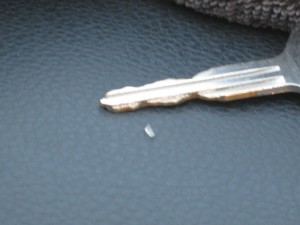
Small bit of glass stuck in my foot last tenth of a mile in Rock ‘n’ Roll Marathon Arizona 2011 January 16 Phoenix AZ
Most bits and pieces of glass just lay flat on the ground, unless disturbed. Which is why our steps should be gentle, and not disturbing to the earth and bits of glass laying on the ground. In case of large sharp objects pointing up, simply try to avoid stepping on them.
Beginning barefoot runners will usually have softer skin on the soles of their feet, sort of “doughy”, so debris is more likely to “stick” to the skin (even when it doesn’t stick IN the skin). This is a good time to practice “removing” glass as soon as it “sticks” in your foot, before it does [more] damage. Most barefoot runners have discovered that about once per year (in the early years) a small splinter of glass gets stuck in the foot. For myself, after several years of barefoot running, I’ve found I often go several years without anything sticking in my foot – and none of those caused any serious injury.
The important thing is not to worry about making barefoot running look bad by stopping to pull out the glass – just do it – otherwise you’ll push the glass deeper into your foot with every other step. When you feel embarrassed, just remember how often shod runners stop to tie their shoes, readjust their socks, or bandage a blister…
Gently
One important technique, you should already be doing, is to run gently – do not pound your foot into the ground and you won’t be pounding broken glass into your foot. This actually takes care of most of the glass on the ground, especially the small hidden bits.
Avoidance
Of course, the first technique for dealing with broken glass is simply to go around it, especially the large pieces that are sticking up.
Clean up
Besides washing your feet frequently, especially if you do have a wound, why not pick up the big hazards from the path you’re running on, so you (and others) won’t need to deal with it next time?
Videos
Wet Feet
Doesn’t water soften the soles and cause more wear while running barefoot?
Some barefoot instructors are telling people never to run when their feet are wet. My friends in Seattle were very happy to hear that I disagree with this advice.
In fact, several of my fastest barefoot marathons (26.2 miles) have been in the rain.
I believe the problem may occur when beginners (or experts) start increasing their mileage and/or speed when it’s raining. The solution is to not run further in the rain, than you could or would on dry surfaces without excess abrasion. It really does boil down to a “technique” issue, since most abrasion can be eliminated (or at least reduced to a minimum) with improved (gentle) running technique.
In some cases some of us have noticed either increased sensitivity in or after rain on wet ground, or perhaps because the sharp edges have been cleaned of dust (which may have softened sharp edges somewhat) that they actually are more abrasive. Also, in cold rain we may lose sensitivity and not notice we are running abrasively which could result in excess wear. In all of these cases, however, good running technique should solve the problem (as long as you aren’t running any further than you are already prepared to run).
Hot Tubs
But DO delay jumping into a hot tub after running, especially if you’re already overheated, long enough (in the worst case, maybe 90 minutes) to cool down first. Otherwise you risk serious overheating.
On a hot day, you might want to (if available) jump (or wade) into cooler water before soaking in a hot tub.
Clean Feet
How do I clean my feet after running?
Let the water do the cleaning. Do not try to scrub your feet hard. This will stimulate the growth of callus, and micro-abrasions can also become infected (especially if you put your damaged feet inside shoes).
If you haven’t cleaned your feet adequately outside, then wash them inside as soon as practical (preferably before tracking dirt all over the house). Try to enter via a door near a restroom, preferably near a bath tub or shower.
If the shower or tub is one of the newer plastic tubs (rather than cast iron covered with porcelain) then be extra careful not to grind your soles into the floor of the tub/shower. Better yet, be careful no matter the surface, and even when you aren’t in the shower – after all, whenever you’re not running, you can still practice some of the techniques for improving your running.
So, first get the floor of the shower/tub wet, then gently step into the shower/tub, without grinding or twisting your feet when they are on the floor. Now continue spraying water on them (if in a shower), or soaking in the tub while lifting your feet one at a time and setting them down gently. Let the water soak in for a few seconds/minutes.
Then take a wet and soapy scrub pad or washcloth and GENTLY scrub your soles while still spraying water (or soaking) on your feet.
Rinse some more, and then rinse again. If you’re going to put shoes on your feet, be sure to dry them thoroughly, even between the toes. Also wear absorbent socks, preferably natural fiber. Better yet, whenever practical, set your feet free and let them breath.
Supplemental Washing
In addition to regular washing, take any opportunity that is practical to get your feet wet. Run in the rain, walk through puddles (if you’re reasonably certain there isn’t dangerous debris hidden in the water or mud), walk or run in shallow water along the beach, walk or run, occasionally on wet grass, etc..
Heat and Bare Feet; blisters or not?
Contents
I’ve heard some interesting arguments against barefoot running, for example “you couldn’t run a full marathon barefoot in Phoenix, Arizona, in July at noon – therefore barefoot running isn’t worth trying”…
Well, reasonable people wouldn’t run marathons (even in shoes) in Phoenix, in July, at noon either. That’s why Marathons in Phoenix are rarely, if ever, run in July at noon!
Anyway, the average temperature inside shoes is hotter than outside. It’s just that” frying pan” asphalt surface we need to be careful about how much time we spend on it … well, that and the fact that it’s might be really hot outside!
So, lift your feet quickly. If the pavement is really hot, lift your feet even more quickly! … and maybe try to get off the pavement, or at least onto cooler pavement in the shade.
Remember our soles are the proverbial canary in the coal mine, an essential part of our early warning system. Soles are extremely sensitive to warn us when we’re running badly, or at a bad time of day, or on the wrong surfaces for that time of day, for too far, and/or too often, too soon. These warnings are not simply to protect the feet, they protect the rest of our body from impact, excess or improper torque, and let’s include overheating too.
So, first thing to ask yourself when you soles are getting toasted, “is it too hot for you to run?” Not just for your soles, but for your body. Sometimes you simply should concede that running in extremely hot weather might not be something your body is ready for, yet, and your soles are simply trying to warn you to avoid too much, too hot, too soon.
However, just because it isn’t hot when you’re running, doesn’t mean the pavement hasn’t been warming up all through the day. Like in the evening of a very sunny spring day, the pavement can become much hotter than the overall weather would indicate.
In any case, there are limits to what our bare soles can do. And that isn’t a bad thing. It is usually a warning. After all, there are limits to what our body can do. And in all of my experience running barefoot, I find that what my soles aren’t ready for, my body isn’t ready for either. Sometimes, it’s simply time to take a break…
But, that doesn’t mean that we are simply incapable of extending those limits by improving our technique, and running smarter, or building up gradually over time, or that our feet are inadequate – that would be like saying that quality control inspectors are “too sensitive” because they don’t like it when we ship defective products from our factories to our customers. No, what it means is we need to figure out how to build better products that pass inspection.
We (our bodies) are the customers of our running (the product). Each step carries our body. And the quality control inspectors (our bare soles) will try to prevent us from shipping bad product (bad running technique). If we imprison the quality control inspectors (put them in shoes) so we can continue to run badly, without being made aware of it, the result could be, in the long term, serious damage to our body.
Summerizing Soles
That warning stated, each summer, there will be days in which the pavement becomes very hot, compared to other days in spring, and some of those days, the weather might not be nearly as hot as the pavement. On those days, limit how far you run, but don’t avoid the pavement all-together, as there is some conditioning (re-conditioning) needed each spring season. (what some of us have called “summerizing” our soles). As with any new activity that we haven’t done for months (over the winter), conditioning our soles for hot surfaces will take time, and several outings, and we should be careful to limit these outings to avoid blistering, as I don’t believe that healing blisters is any faster than a more conservative toughening without blistering approach.
In the meantime, when you are on hot pavement look for cooler options, at least occasionally; grass, lighter colored surfaces, painted white lines, dirt, and gravel – rough surfaces have more air between the points contacting the sole, and also encourage you to lift your feet more quickly (and not to push them into the ground harder). Make a point to pay attention to how your soles feel. Focusing on how far, or how fast, or how often you “need” to run can distract us from figuring out HOW to run, or When to seek shade on a hot day.
By June (or July depending on your climate), or December or January (depending on your hemisphere), if you’re using good technique (especially fast cadence), your bare soles should be able to run reasonable distances at reasonable times of the day without damage.
There also seems to be a tissue memory for this conditioning. Over the years, the conditioning can occur in progressively shorter and shorter periods each spring.
Should I avoid rough surfaces until I build up more calluses on my feet?
Contents
Rough surfaces are the ideal terrain to begin on; You won’t be tempted to do too much too soon, before you have learned to run gently enough so that rough surfaces won’t be so “un-bare-able”, and before your feet are ready.
Rough surfaces are often “bare-able” if one has practiced on rough surfaces enough to learn to run more gently than is necessary for smoother surfaces. Being able to “bare” these terrains has a lot to do with learning to relax, despite an initial urge to tense up. But tensing “up” results in pushing our feet “down” with even more pressure into the rough surface making it even less “bare-able”…
Also tensing up tends to put us up on the balls of our feet (or worse on our toes), so that now all of our body weight is distributed over a smaller surface and few points. Think of a bed of nails. If we put our full body weight on a small part of our body the nails will puncture. If we spread our weight over as many nails as possible each nail has only a small amount of pressure and the many many points can support our entire body. Each point only has a few ounces pushing down on it.
Making Sandals
Tough Soles
Contents
Toughening Soles
If you’re trying to toughen your soles to endure the abuse of barefoot running, then you really don’t understand how barefoot running helps prevent injuries – by teaching us to run more gently, by re-learning how to move our body in a way that doesn’t cause pain in the soles. It is NOT about toughening the soles, it is about making running easier, gentler, more efficient and graceful.
In the topsy-turvy world of barefoot running sensitive soles are a benefit, not a hindrance. Tough soles are a hindrance … to learning HOW to run better. It is precisely because we have sensitive soles that we can learn to run gently, by learning how to move in ways that avoid the pain caused from pounding our feet into the running surface, Whenever we are running in a way that could be injurious in the long run, our bare soles are sure to let us know, emphatically and immediately, with each and every step that we don’t correct this bad technique. If it hurts to run barefoot on most any surface, then you still haven’t learned HOW to run the way your body wants to run.
And it really isn’t about “working” at it, running, after all, should not be an “endurance” activity. Running should be easy and gently, not something difficult and painful to be endured. Learning to run barefoot is about finding the easiest, gentlest, most efficient and fun way to move our body in the direction we want to travel (generally that will be forward).
So, yes there are some basic techniques that can be taught. These are essentially the same basics that experience barefoot runners have learned by testing and playing with various ways to move the body over decades of barefoot running by listening to their own bodies and soles.
But, essentially there are two fundamentals to remember:
- The goal of running is to move the body in the direction we want to travel (generally that will be forward).
- The goal of learning to run while barefoot is to learn how to move the body in the direction we want to travel, as easily and gently as possible.
Of course, the second fundamental incorporates the first, so to test any element of running technique we really only need to figure out if it helps move us forward, easily and gently, or at the very least, does not impede our forward travel.
Pain and Injury
If I loved pain, I would wear SHOES! -Ken Bob Saxton
Pain
Pain is not an indication that you need to suck it up and endure more pain.
It is a message that you’re doing something wrong, incorrectly, injurious, possibly even stupid. Think about it, that pain in your hand every time you stick your hand in the fire, do you really believe it’s trying to tell you to leave your hand in until it’s tough enough?
Well, that may actually work – your hand will turn into a hard, tough chunk of charcoal in time! But, not very useful except maybe for making charcoal drawings.
No, seriously, pain is telling you to remove your hand from the fire. Pain while pounding our bare soles into the ground is trying to tell us to run more gently, more efficiently, more gracefully – to stop pounding!
Our feet are far more sensitive than necessary to simply protect the feet – isn’t that really the reason most people wear shoes? But, this sensitivity is not a mistake of evolution, I believe that the excess pain in our feet from strains that do little real damage to the foot, exist to protect the rest of our body from excess stresses and strains. That it, yes it is extremely painful to slam our bare foot into the ground, and it doesn’t do proportional damage to the foot, certainly not immediately. But it does encourage us to land more lightly, putting less impact damage over time on our knees and spine.
So putting shoes on so we can continue running comfortably while slamming our feet into the ground, doesn’t really protect our feet from injury. But it does protect us from being aware of how much impact damage we’re doing to other parts of our body (which don’t have as much sensitivity – at least not until after they are badly damaged)
Injury
Pain is not the same thing as injury, though when we ignore pain the thing that is causing the pain can cause injury. And when we are injured, and use the injured portion of our body in a way that puts excess strain on it, we feel pain.
The reason we feel pain is to avoid injury, like with our hand in the fire, to avoid burning the hand, or turning into a lump of charcoal. Without pain we would be senseless, and probably wouldn’t live very long.
Or to allow injuries to heal by encouraging us not to put excess strains on our injured body parts.
If you are injured, you need to heal. In the meantime avoid straining (hurting) the injury. If you can figure out how to move or walk or run without causing pain to the injury, then you probably have eliminated the original cause of the injury. The key is to listen to your own body (and soles).
If you can’t, or until you do figure out how to move without causing pain to your injury, you should be resting, at least the injured area. You might even consider a “cast” … because they’re probably far too supportive for healthy feet, your old running shoes might suffice – as Michael Sandler calls them, “foot recovery devices. Just remember, if you need the shoes (or an actual cast) Then it isn’t time to be running!
If shoes don’t provide enough immobility to facilitate healing, then check with your Health Care Provider – or better yet, if you trust your Health Care Provider, check with them now!
Ankle Pain
Even Terrain
The good news… If the pain is a sharp pain on the outside of the ankle AND if you have been running mostly on consistently even terrain (roads, sidewalks, etc.), you probably can fix it up with a quarter mile or so of walking – in a certain way, preferably on soft uneven terrain.
Regardless of any other issues, let’s assume for a moment that you have been running too much on flat, consistent terrain, since it’s an easy fix in a few minutes. If this isn’t the case, you’ll know soon enough.
The problem with roads and sidewalks isn’t the hardness (as many “experts” who have never run barefoot on roads and sidewalks have been telling us for decades). The problem is the consistency, the lack of variation, especially if the terrain is also mostly flat (no hills). The ankle joints kind of work into a groove (and on flat terrain, a short groove). Think of the ankle as a joint that only flexes in one plane, front-to-back. It’s going to hurt whenever we try to flex that joint the least bit out of that plane.
Ironically and counter-intuitively, that’s exactly what is needed – to break out of the groove, to flex in various directions, under load – simply flexing the ankle when it isn’t supporting our weight doesn’t seem to help much.
Cool thing is, you’ll know very quickly if this is the case, as it should begin improving from the first few steps. If it doesn’t, then you may have a more serious problem, and should get it checked by your health care provider.
First of all, find some grass or soft sand (yes, I know I don’t recommend using these surfaces for learning, but we do need dessert occasionally). Preferably, not too even a surface. A manicured lawn, raked beach, golf course, or smoothly raked volleyball court, will not provide the necessary variation.
Be sure to bend your knees BEFORE landing, keep your torso vertical, face forward, etc., etc. (all the other basics How-To’s of Barefoot Running which you should be aware of BEFORE you begin running barefoot).
Instead of landing on the outer edge of your foot, focus on landing on the inner edge of your foot. But still your feet should be walking along a relatively straight line (while allowing for the uneven terrain), and maybe even exaggerating the movement, by swinging each foot across the line a bit… example, swing your right foot over the imaginary center line you’re following so that it lands to the left of the line, and swing the left foot across the line so it lands on the right side of the line. REMEMBER keep the knees bent, and stay relaxed. Excess tension rarely reduces pain.
Keep in mind, this is an exaggeration of some of the fundamental techniques designed to flex your ankles and solve an immediate issue. This is not the way you will ultimately be running.
Ultimately, to avoid this and other problems in the future, walk and run on a variety of terrains, be sure to practice the basics of good barefoot running technique, while also listening to your body and soles and responding appropriately to the stimulation and messages your own body is telling you, so that you can continue to improve your techniques, and also respond appropriately to variations in terrain.
Use the guidelines in the “Begin Here” and “How to Run” section of: BarefootRunning.com … though the website may be unavailable for a bit, as more people are probably trying to access it after the Runner’s World mention of my book, “Barefoot Running Step by Step” – which is a good reason to BUY MY BOOK!
Finally, if this hurts more or the same as before, and isn’t beginning to feel better within the first 10-20 yards, then you may have an actual injury, and need to investigate that further with someone who knows about injuries (that isn’t me)…
Otherwise walk about a quarter mile, more if it feels good, and keep trying, testing, and experimenting as you walk, so you get even more variation in the way your foot, ankle, and body moves – and perhaps you’ll also learn something along the way, about how to move your body more naturally, gently, and efficiently.
Uneven Terrain
Running too far (with or without shoes) on uneven terrain can put more strain on your ankles than they are used to, especially if you are wearing shoes with a huge flange-like sole, and or tensing up to avoid letting the ankles flex naturally. Relax, and avoid doing too much too soon on any new terrain – just as you would if you were beginning any new activity that your body and mind are not conditioned or trained for.
Sprained or Twisted Ankles
The bad thing is that you’ll probably need to take some time off running, especially for a bad sprain. The good news is that you’re less likely to suffer a badly sprained ankle while barefoot. The added height of shoes, and the added width of the sole increases the leverage against the ankle, and the negligible feedback in shoes, reduces our ability to respond appropriately to uneven terrain, greatly increasing the risk of spraining an ankle when we do encounter uneven terrain.
Foot Pain
Contents
Pain
Yes, occasionally my feet hurt. One of the main reasons to run barefoot is because it will make your feet hurt. If running barefoot didn’t hurt, we might not realize that we need to change the way we run, so that it doesn’t hurt. Listening to foot pain (and figuring out how to run without causing foot pain) is one of the quickest ways to learn to run smoothly and naturally. Think about it, if it hurts right now to run with technique that could cause serious or chronic injuries in the future, there is a lot of incentive to correct the way we run right now.
If my feet hurt because I am running barefoot, then I am either running badly, or running too much too soon. It is rare that a barefoot runner over-trains on challenging terrain to the point of chronic injury. It is also rare that a barefoot runner will purposely smash his or her heels into hard pavement or rocks.
Teaching us to run and walk more gently is exactly why our soles are so very sensitive!
Top of Foot Pain
Top of Foot pain is the most commonly reported injury from running “barefoot” – though the feedback I get (from emails, discussion groups, and in my workshops, and presentations) indicates it is nearly exclusive to runners who use minimalist footwear (which some refer to as “barefoot” running shoes), or those who avoid challenging surfaces while trying to learn how to run barefoot (It’s the challenges that teaches us the most).
In any case many of us have experienced pain on the top of the foot – sometimes following a distinct “snap” sound during push-off (or in my case, once when I kicked a sand hill – details below). And in most other cases, the top of foot pain comes after suffering excess calf pain. The reason for this is because tense calves put excess strain on our feet, but the calf muscles being softer tissue will complain first. It is ignoring this calf pain, or hoping it will pass as our calves get stronger, that often leads to the dreaded top of foot pain.
I’m no doctor, but I believe that, living in a shoe-addicted culture, our foot muscles, tendons, ligaments, even the bones, atrophy from lack of use. In any case, I do have the benefit of the experiences of many other (especially newbie) barefoot runners behind me.
Though not from “pushing-off”, I have personally experienced a similar pain, following a snapping sound. I was running on the beach several years ago (barefoot – naturally), and I didn’t pick my trailing foot up high enough to clear a sand hill. When I kicked the sand hill, it torqued my foot backwards, and I heard/felt a loud snap. The interesting thing, though probably I shouldn’t recommend doing this, is that I not only finished a 5K race the following day, without any pain, by using the techniques outlined below, But I even managed to finish 2nd in my age division! (O.K. it was a relatively small event for Los Angeles, CA).
But on to the actual problem…
Ever try learning a new song while wearing earplugs?
Many folks, particularly those wearing “transition” footwear, might think that these pains are simply a result of trying “too much, too soon”. But, If we had actually been barefoot, we probably wouldn’t do too much too soon, our soles would complain, LOUDLY. And “too soon”, doesn’t necessarily mean “before we have toughened up” (to endure our off-key singing) – it really should mean, “until we have learned to sing on-key.”
When we remove rigid shoes, and especially if we replace them with minimalist footwear – which blocks some of the feedback from our soles, feedback which would encourage us to change our running technique, to a more gentle way of running (singing on-key), which would reduce stress on our feet (and the rest of our body too) – and then those minimalist shoes don’t provide the support necessary to do the “push-off” we might be used to doing in more rigid shoes – that is, we continue to run as if we had the support of rigid shoes, without the support of rigid shoes – then, we are asking for trouble!
It’s like getting used to hitting yourself in the head while wearing a helmet. Then removing the helmet and expecting that you should be able to continue hitting yourself in the head just as often and just as hard! But, it isn’t that we should be able to hit ourselves in the head repeatedly without a helmet, the idea is to have the sense to NOT hit ourselves in the head, whether we’re wearing a helmet or not. After all, a helmet isn’t protecting your neck or spine from damage caused by the impact of hitting ourselves in the head. Much like shoes, which may protect our feet from the immediate pain of bad running technique, do not protect our knees, hips, and spine from long-term damage caused by bad running technique.
Pain Avoidance
The best way to avoid this type of injury (and perhaps most running injuries) of course, is to transition to Running Barefoot, by;
- Removing our shoes
- Not replacing our shoes with lesser shoes!
- Taking the time to relearn HOW to run, this time, gently, as if our shoes aren’t supporting and cushioning our feet, while gradually allowing our feet to build and develop from the gentle exercise they had been denied while living inside rigid shoes.
Take the time, like a child, to feel the earth beneath your soles, to discover how it feels for your soles to interact with the earth, to play and experiment (are the two really different?) with touching the earth with your bare soles. And since you probably aren’t an infant, to understand that it can take months for your bones, tendons, ligaments, etc. to develop the strength necessary to run barefoot – and that is if you have taken the time and attention to learn how to run gently!
How Strong Do Our Feet Need to Be to Run Badly?
It will take much longer, if ever, to toughen your feet enough to run badly while barefoot. I can’t even begin to guess how long it takes to develop the strength to run badly, without injury – perhaps forever, as many folks who try (with or without footwear) seem forever plagued with pains and injuries (their solution, sadly too often, is to take pain-killing drugs, and run even more).
If we are trying to run the same way we ran with shoes (assuming we weren’t, then, running as if we were barefoot), except without the rigid shoes, then we are most likely going to, at some time, suffer from some sort of pains, as we are discussing here. And rigid shoes are going to create their own set of problems, so best to just Run Barefoot, naturally, or at least, as if we were barefoot. But, before we can run “as-if” we are barefoot, we must first, almost necessarily, be barefoot – we must remove the earplugs, so we can hear the tune, and learn to sing on key!
Starting As If Going Barefoot Is New to You – Because it Probably Is New to You
Standing, walking, and running, while barefoot, exercise and help develop muscles, tendons, ligaments, etc., on the top of the foot, but only if we run correctly – and most beginning barefoot runners do not run correctly. After years of wearing shoes, and trying to “power” themselves through each run, pushing-off has become an ingrained habit. Add to this, that we, sadly far too often, get the advice (usually from “experts” who have never run any significant distances while barefoot), that “Running Barefoot IS running up on the balls of our feet” – but Running Barefoot really is NOT running up on the balls of our feet – NOT if we want to run barefoot without injury, in the long-run (so to speak).
Building up Gradually
So, as we build up distance walking and running barefoot, the plantar (sole) muscles, grow stronger with exercise, and we often end up straining the weak upper foot muscles (until we begin to change our running technique as described below). This pain is like some sort of counterpart to Plantar Fasciitis, a similar pain in the soles and heels (common among shoe-wearers), which seems to respond well to barefoot exercise of those tissues.
Exercising While Walking or Running Barefoot
I used to recommend the Extra Exercise below, for top-of-foot pains. But, more recently, have come to the conclusion that the best solution involves learning HOW to run barefoot, which, when done as described below, will provide the same sort of exercise with each and every step, as well as providing a less stressful, more gentle stride. Specifically, the problem seems to occur (along with other problems) if we have a tendency to “push off” while running (and most of us do have this tendency – just look down and watch your trailing foot, just before you lift it off the ground), and especially if we add the “ball-of-foot” landing as mentioned above – so that the foot never really gets a break, or at least not a good break, as in a rest, but it is likely, eventually to get a break, or at least a severe strain, if we don’t give it a rest, by letting the pressure distribute across the entire sole, by keeping our heel down.
But It isn’t just about NOT pushing off, but also a failure to let the ankle flex as the foot is lifted, resulting in too much pressure on the balls of the foot, and strain along the length of the foot.
Instead of pushing off, begin lifting your foot BEFORE it lands. Also, do not try to get up on your toes. Instead, try to keep your heel on the ground, until the foot begins to lift. In keeping your heel down, you will be exercising the muscles and tendons on top of the feet. Basically, while the foot is in contact with the ground, try to keep your entire sole on the ground.
But, let’s go a step further, and take an ACTIVE roll in this. Let’s PULL the front of our foot up, in order to allow the heel to stay on the ground – actually, we WILL need to pull the front of the foot up, if our knees are bent enough – if we don’t NEED to PULL the front of our foot up, then we NEED to bend our knees more…
In reality, our heel will still be coming off the ground before our forefoot, however, the act of TRYING to lift the forefoot with the heel, will reduce the strain on the foot. In a video, these techniques look identical – that’s why we must realize that what the observer sees another runner doing, does not tell us much about what the other runner is feeling – and how running feels, while barefoot, is one of our biggest clues as to whether we’re running in a way that increases our risk of injury, or not.
And that’s how we prevent (or at least reduce) these injuries. If you are already injured, try the following simple exercise, which I devised, and have recommended to folks who have suffered this type of injury or pain in the top of the foot, and have found this GENTLE exercise to help (I now believe these exercises is not necessary, if we follow the above advice on lifting the forefoot while running and walking).
Extra Exercise
Note, this exercise is no longer necessary, as I’ve discovered that you can get a better version of this, with every single step you take, while walking and running, simply by lifting your WHOLE trailing foot (not just the heel) – a fore-foot lift. But the exercise is good if you’re already suffering top-of-foot pain caused by mistakenly tensing your calves and trying to stay up on the forefoot.
Place a small weight (up to 5 pounds) on top of the toes, and resting the heel on the ground, GENTLY lift the weights a few times each day, with the front of the foot.
With a small dumbbell you can curl the toes up, to keep the dumbbell from rolling off the front of your toes, while lifting. Leave only the heel of the foot on the ground, while raising the entire fore-foot. If you try lifting the weight with only your toes, while keeping the balls of your feet on the ground, your toes probably won’t be long enough to lift the the dumbbell.
The heel can also be raised slightly, by placing it on a book or board or something, which tilts the foot forward, and keeps the weight from rolling too far back on the foot.
As far as body position, I’ve done this exercise lying on my back, with my knees up, sitting on my butt, with my knees up, sitting on a chair with my knees bent, or even standing, with my knees straight (but not locked), and lying on my stomach (see below).
Also, since this isn’t a case of injured tissues, or overuse, but more a case of tissue not getting enough exercise, in my experience, the pain does not go away UNTIL I do the exercises! (or change the way I run – see above)
Just be certain to pay close attention to how it feels WHILE exercising. Be sure to exercise both feet, even if the other foot doesn’t hurt… YET…, and respond appropriately. If any of these exercises exacerbate the pain, then STOP! If the exercises cause sharp pains, there may be some tissue damage to address with your health-care provider.
In my case, the feet seem, immediately, quite happy to be exercising (and running correctly) – though in all fairness, it took me a few weeks to figure out this exercise, so some healing had already occurred (but the pain persisted, until I started the exercises).
Do NOT be afraid to try variations of this, and other exercises! Remember, it is lack of variation or balance that likely contributed to the problem in the first place.
Another variation can be done while in bed, laying on the stomach, and hanging the feet over the edge of the bed. GENTLY push the top fore-foot against the side of the mattress. Remember, GENTLY. This is not a contest to see how far you can drag your body toward the edge of the bed, this is about gentle balance. If you build these top muscles too much, you will be out of balance, once again, with the muscles and tendons in the soles, then your feet might start curling into a ball. Besides, you might never be able to fit your bulging muscular feet inside shoes again – hmm… maybe that’s not such a horrible side-effect, after all…
Stretching
Contents
Stretching
Many people strain too much when they stretch. Stretching should not be a “forcing” of our joints to bend, and our tendons to stretch. It should be gentle, and it should be done AFTER we have warmed up our muscles, ligaments, and tendons. One way to warm up is to run, starting out slowly and going a bit faster as we warm up. This is the reason many experts now agree that stretching is best done AFTER finishing running, rather than preceding running.
Personally, I believe we should not be stretching for running, we should be stretching for life. Rather than waiting until you go for a run, we should simply be moving and flexing our bodies throughout the day, starting when we wake up with a gentle cat-like stretch BEFORE we leap out of bed, and then do NOT leap out of bed, get up gently and gracefully.
Training Schedules
Contents
Schedule
Following a schedule to increase distances over a certain period is not unlike advancing from one grade to the next based on a time table, rather than on whether or not the student is ready to move to the next grade (though sadly this is often the case in schools).
When we run any “long” distance, learning something new is difficult. Rather than experimenting and playing and trying to figure out how to run, we tend to run the way we’re most comfortable running (just to achieve the short-term goal of finishing this run), that is the way we have always run before, or something very similar (a way to run which was most likely learned while wearing shoes).
So like the student trying to “get through” this semester, we spend less energy learning, and more energy just trying to survive the pain and embarrassment of getting low grades.
Actual Learning
Listen to your body, listen to your soles, before moving on to a new distance … don’t even try running any distance until you have re-learned how to run barefoot (start out with standing barefoot, then walking barefoot, preferably on an uncomfortable/stimulating surface first).
It’s difficult to experiment with anything except the most minor adjustments while actually running, especially if we are set on covering a certain distance, even worse if we’re set on covering that distance in a certain time. We need to free ourselves to play with various ways to move, varying our techniques to test these movements and techniques beyond the “sweet” spot. Because if we don’t go beyond the sweet spot, we can never be sure if we’ve even come close to the sweet spot.
We need to be able to play, and if we have a set goal of a set distance, and set goals of increasing those distances over a set time, there is little room for play!
Essentially, we should be taking the basic techniques that seem to work for most people, and have been tested personally by me and millions of others over many eons, and fine tune them for each individual body, as that body changes, evolves, even gets injured and heals over time (for example, some people with leg length discrepancies from traumatic accidents are successfully running barefoot, because of the interactive feedback that is unique to barefoot running), and with each and every day, over various terrains, with each and every step.
Don’t mess with Technique?
Contents
I’ve heard that runners should never mess with technique, because it may hurt them?
Many of us have heard coaches and athletes bring out this old bone, which more accurately should be, “Don’t mess with successful technique.” But, most runners don’t know successful technique, and most people aren’t even runners, mostly because their running technique never was close to successful, in fact, quite often their technique was injurious, and at best, boring, un-stimulating, and painful.
The Old Days
When this rule came about, there were many factors at play. First of all, most coaches didn’t know how to teach successful running technique. Coaches were successful more for their skills in recruiting talented runners, than for their ability in improve running techniques of poor runners. And most people who were running, racing, and being coached were already successful. Coaches rarely worked with unsuccessful or “untalented” runners. And most runners who weren’t successful, didn’t continue running because running was more of an elite sport, with just a handful of competitors in most race events.
Now we see tens of thousands of runners (and walkers, crawlers, wheelchairs, etc.) in any big city marathon (and there’s more big city marathons than ever), even in some 5K races we’ll see just as many runners, or perhaps we should say, “participants” as many are walking, using wheelchairs, even crutches.
Coaches Teaching Technique
Today many people, regardless of talent, can find coaches willing to help them improve their running technique (or at least try to encourage them to run further and more often) for a price. Still, even for those who can afford private coaching, our most attentive teachers are the bare soles of our feet, which have long been ignored in the tenuous quest for improving running technique. Now, as we free our feet from imprisonment, we once again have these tools available to us, to help re-learn, or fine-tune our running technique.
What about messing with “successful” technique?
Tiger Woods, arguably one of the most successful golfers ever, is now on his third re-tooling of his swing technique. The first two times he re-tooled, he came out better than before. It may be too soon to tell if the third time will also be an improvement, but it really doesn’t matter, at least he’ll know, one way or the other, and if it doesn’t improve his game, he go back to one of the other techniques that were successful for him, or look at other ways to re-tool his technique.
Old pros, like Nicklous, Watson, and Palmer didn’t have coaches who taught or analyzed technique like we have today. This was true for running as well. Athletes might occasionally get a hint from a coach about fine-tuning, but mostly each athlete worked it out for themselves.
In high-jumping, when Dick Fosbury first used the Fosbury Flop, people thought it was ridiculous, that is until Fosbury won gold at the 1968 Summer Olympics… Of course, the Fosbury Flop would have been ridiculous in the old days, before thick landing cushions were used. Kind of like “jogging” (over-striding or heel-striking) would have been ridiculous (and still is) for barefoot runners and old-style racing flats. Jogging didn’t come to fashion until that sort of landing was made comfortable by modern over-cushioned running shoes. Of course, it isn’t a very successful way to run, that is not many races are won by people who hit the brakes with each and every step. Races are still mostly won by people in thin running shoes (or bare feet), whose technique contributes to forward motion (the heel-strike that occurs when we over-stride has a decelerating/braking effect on each step).
But, back to Tiger Woods, who is currently being criticized once again for messing with his unparalleled success by re-tooling his swing for the third time in his career. You’d think the critics would have learned by now, after all, the first two times he re-tooled his swing, he became a better golfer. I guess, like barefoot running, critics often fail to take into account feedback. Tiger Woods, in playing with his technique is going to be constantly paying attention to how it affects his game, and if some changes don’t have any indication of contributing to a better game, he’s going to be looking for other changes.
It’s much like evolution; it isn’t just a bunch of random mutations – it’s a bunch of random mutations tested over and over again by the environment in which they occur. Those changes that don’t work well, don’t continue for long.
Likewise with barefoot running, except the feedback is even more immediate; if it doesn’t feel good on the bare soles, then that is probably the best indication that a particular change in technique isn’t going to improve our running. Contrariwise, if it feels great on our bare soles, especially on various surfaces and terrains, then that is an excellent indication that we are becoming more efficient, graceful runners.
But, for those who are satisfied with the way things are, even if one is on top, well, you probably won’t stay on top for long. Fact is, one of the cornerstones of modern quality assurance is, not being satisfied with being “good enough”, but rather, continuous improvement. And no reason to wait to try to improve, just because you’re already faster than everyone else … whatever happened to “competing with oneself”? Doesn’t that apply to those in front, as well as those of us in the middle or back of the pack?
Even if we forget about those other fast runner behind us, who you can bet will be trying new ideas to increas their chances of catching you, if you aren’t willing to play with your technique, you’ll never know if you could be running better (or safer).
And, for most people, who are running badly enough to get injured frequently, there’s simply no good reason not try to improve your technique.
How to Play with Technique
First of all, try things that have worked for other successful runners. The basic techniques in “Barefoot Running Step by Step“, or the How page on this website, or from other “barefoot” coaches, are a good places to begin. These are just basics, starting points, which have been tested successfully by many other runners, particularly barefoot runners. And it is barefoot runners who require the best technique to avoid immediate pain in the bare soles as they interact with the running surface; it hurts to run badly barefoot, which is why we tend to learn to run better, sooner.
Advanced Barefoot Technique
I’ll be writing some articles about Advanced Barefoot Techniques soon
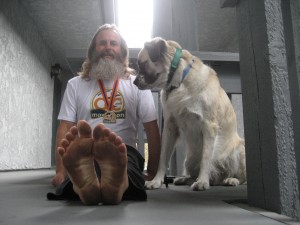

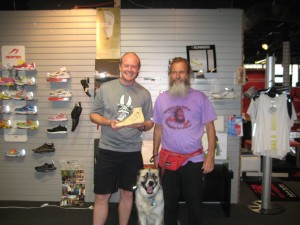
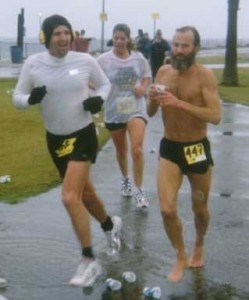
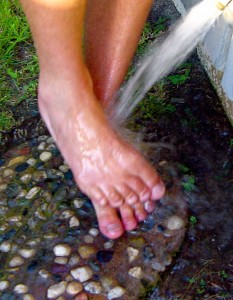

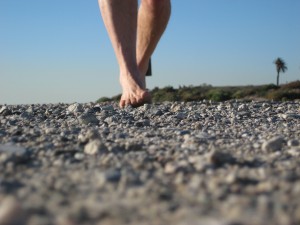
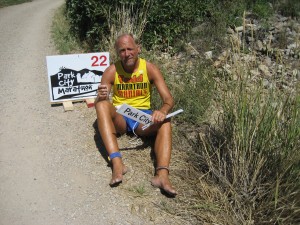
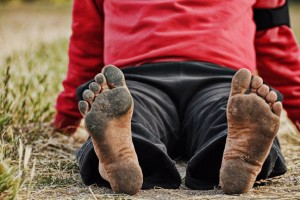
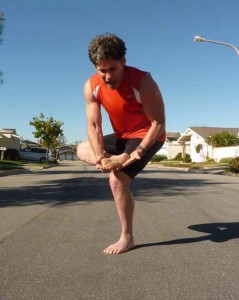
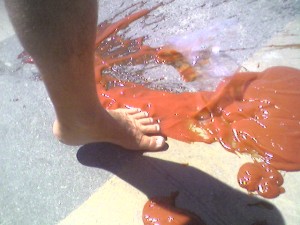

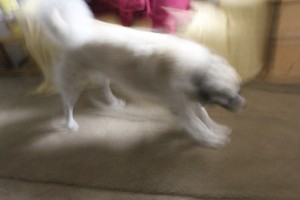
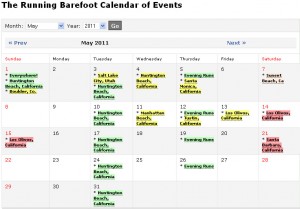
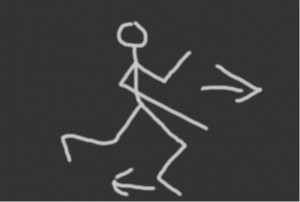

Hi Ken Bob! Please explain how to run barefoot uphill fast. Particularly, how to sprint up moderate and steep hills. Thank you!
One should only be “sprinting” up hills when running short distances. That’s actually what sprinting is about. If you want to be able to keep going after you get up the hill, then hills are a good place to take it slow.
Okay, so what if you are running short, and uphill? Then the technique is pretty much the same as on level ground, except you’ll need to have very flexible ankles. Just move your body (vertical torso) in front of your feet, and let your feet chase. The uphill will come much easier than you think, with very little, if any, conscious push-off. The springs in our legs will still propel us forward, and slightly up. So, it’s still just a matter of lifting the feet, albeit a bit higher than normal, in order to keep up with our ascending body.
Whenever you’re going up stairs, avoid the elevator (unless you’re moving something with wheels), and practice up the stairs. You’ll see that by moving your vertical torso in front of your feet, and letting your feet chase, you should start accelerating. Of course, stairs are a bit easier, because your ankle won’t need to flex as much. Still, it’s good practice instead of taking an elevator where you only practice standing still.
I am running now for more than 40 years. I have never thought about running barefoot. But after reading your post I feel really animated to try it out! Thank you very much for sharing your thoughts.
Hey there. I have a question/concern: I started running in January of 2015 and like a lot of new runners I made all of the mistakes (too much, too soon; normal shoes; arch supports; heel strike). But April I was up to 23 miles per week and had a stress-fracture below my left knee and plantar fascitis in my right foot. After a two month break (during which I read, yes, Born To Run and switched to a completely barefoot lifestyle) my stress fracture healed and I learned to change my stride and strike. The problem is, the plantar fascitis remains. I can’t run more than about a quarter mile without the pain coming back. Everything I read suggests I need orthotics, but I don’t/can’t/won’t accept that. Nevertheless, I can’t run with the soreness. What would you suggest? I’m really impatient to get back out there and run barefoot!
1. after you have been sitting, or lying down for a while (especially in the morning when getting out of bed), stretch GENTLY. No special stretches, just some nice overall stretching, much like a cat or dog would do. Then get out of bed or off the chair/sofa/whatever gradually (do NOT JUMP out of bed!)
2. be sure to bend your knees a bit while walking and running (spend more time walking for now), and be sure your torso is vertical (not leaning forward). The torso should be moving forward while walking or running, but not leaning (in other words, your head and shoulders should be above your body, not leading the way). All of this removes impact and pressure from the heel while landing. Also similar advice while standing; let the knees bend a little (not locked in hyper-extension), lift your feet occasionally, even (or maybe especially) while standing in one place.
3. I and others have had some good results from following this advise: https://barefootrunning.com/?p=2904
Hope that helps.
Thank you so very much! I will definitely give it a shot!
I just started reading Barefoot running, and Over the years have had many injuries especially ankle, shin splints. I purchased Walkfit orthotics before I started reading, and am seriously wondering if I should return them and learn more about barefoot running to help with my injuries. I am so excited about the book and will try it once I learn more, but do you think I should keep the orthotics, maybe for my daily non running life. Please let me know, and thanks so much.
This is really something you’re going to need to decide for yourself. Think about the various factors, do the orthotics help you at all, are they ridiculously expensive (like more than you would pay, if you didn’t believe they were absolutely essential). I’m no fan of orthotics, but then I’ve never really had a “need” for them either.
I think I;m the classic “too much, too soon” type and have been running 100% barefoot since January this year. I’ve done three half marathons and two full marathons with little or no damage to my feet and feeling good afterwards. My problem is the rough stuff. I have your book about religiously read and practise the techniques but can’t seem to get any faster on poor surfaces. Athens, for example, went really well for the first 7 miles until I hit cheese-grater roads and had to slow right down. An expected time of around 4.30 (I’m slow I know!) came in at 5.45.
There are no “slow” runners. I’ve completed marathons anywhere from 3:18 to 8:10. All depends on the shape I’m in, the course, and whether, how often I stop to take photos … whether I’m in a hurry or not. Anyway, rough terrain is difficult at any speed, but if you run fast, you will be over it in shorter time. The key is light steps, keep your body moving FORWARD, do not try to push off, let your feet follow your body. The more you can move horizontally, and not push your feet down into the rough terrain, the less the rough terrain pushes back.
Loved your recent talk with Steven Sashen. I started running barefoot last year and recently I noticed pain (incoming blister) in ball of my foot right under fourth toe. I have put off running for a week yet the blister’ish feeling does not go away. What can I do to cure it? It hurts sometimes while I am walking and I have to adjust my posture to make the feet “doughy”. With the warmer weather approaching, I do not want to switch to minimalist shoes because I feel they are no where close to feedback I get during barefoot running.
Relax, take care of your feet. Let them rest. If you need to walk somewhere and it hurts to walk barefoot, then wear comfortable shoes. Becoming a full-time barefooter takes time and patience. Even babies don’t start out running marathons barefoot. They start with baby steps (literally).
Also, adjusting your technique in response to pain is exactly how going barefoot teaches us to walk and run more gently. Experiment, play, try different techniques, movements, foot placements, body positions, etc. to learn to move painlessly.
In the meantime:
Doc Wolfe’s Aching Feet Soup
https://barefootrunning.com/archives/6399
Hello Ken, I really appreciate the articles on barefoot running 🙂
I’ve started running barefoot a few months ago and just recently started developing pain in the center area of the bottom of my forefoot (i guess my middle metatarsal area). It is severe enough that I can’t go even a mile without feeling it. It feels as if there is an area of scar tissue there now and it hurts after each stride. I’ve been running barefoot 2-3 miles a week. Walking does not cause any pain. Ever experience this or hear of it ? I really want to continue forefoot running, but I’m not sure what to do now.
Much appreciated,
J.R.
I’m not certain what you mean by “forefoot running”?
I do know that many people who read articles that misquote me, or have learned from the articles (that misquoted me) or misinterpreted research that talks about forefoot landing, have often suffered. I continue to encourage people to emphasize that it is a “forefoot-FIRST” landing, because people confuse a “forefoot” landing with running up on their forefeet and thus putting a great deal of strain on their feet and calves.
I teach people to allow the heel to touch, so as not to produce so much stress on the feet and the calves.
We should not be trying to land on the forefoot, that “trying” part is the problem. It often results in trying to point the foot to force a forefoot landing which means tensing the calves and probably staying up on the forefoot during most of the stride. This results first in weeks of chronic calf pain, often followed by repetitive impact stress fractures in the foot. While one such impact probably won’t break a healthy foot, doing this with each and every step can – especially since distance runners step tens of thousands of times over the course of several days, or even one day.
So, instead of focusing on the foot landing, focus on what the rest of your body is doing.
Besides good posture not being hunched over;
Bend your knees a bit before landing
Relax your calves, ankles, knees, hips, allowing the heel to touch the ground (and take some strain off the calves and foot) after the forefoot-FIRST landing. Your body should be flexing with the landing rather than resisting. This eliminates impact to our body. What’s even cooler, is that it stores the energy from landing in the elastic tendons and muscles providing FREE forward propulsion as the body moves in front of our feet.
https://HOW.BarefootRunning.com